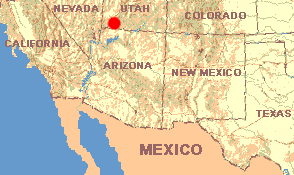 March 31, 1988
March 31, 1988UTAH: Washington & Kane Counties
Backpacking the eastern side of Zion National Park
 March 31, 1988
March 31, 1988At 2:00 PM I begin walking north from the East Entrance Trailhead. It's very windy, partly cloudy and the temperature is 64°. APRIL .
6:30 AM. Camped at Stave Spring, at an elevation of about 7000 feet. With very little wind the sky is clear and the temperature is 22°. Between 7:00 and l0:00 AM I walk from Stave Spring to Deertrap Mountain Overlook. Here are the birds I see, in the order in which they appear:
At l0:00 AM as I descend a steep slope a Least Chipmunk, Eutamias minimus, postures atop a large sandstone boulder. The Least is similar to the Eastern chipmunk, but smaller, without so much rusty coloration, and the two white lines on its face are more conspicuous. This individual lets me come so close that I suspect it of a history of panhandling nuts and trail mix from backpackers.
At 11:35 four Western Bluebirds fly by.
At 3:00 PM, passing from one mesa top to another, a thousand feet above the canyon floor a male Northern Harrier, or Marsh Hawk, has a hard time with the wind. I'm used to seeing this bird sailing calmly and low over marshes and grasslands. Its presence here is hard for my Eastern headset to adjust to.
APRIL 2: Having camped overnight at Cable Mountain Overlook (elevation 6496 feet), with my tent pegged right at the edge of the cliff overlooking the stomach-churning abyss known as Zion Canyon, now let me tell you about the trees found within twenty feetbof my tent.
GAMBEL OAK, Quercus gambelii: Forming dense thickets about ten feet high, this tree bears leaves similar to our three-inch long eastern White-oak leaves.
JUNIPER: Still I can't decide whether these are One-seed or Utah Junipers. They and the Gambel oaks are the most common trees atop this mesa.
PINYON PINE, Pinus edulis: So far we've seen Mexican Pinyons and Single-leaf Pinyons, but this species is just called "Pinyon Pine." While the Mexican Pinyon bears two or three needles per bunch and the Single-leaf possesses one, this species has two. It's about ten feet tall.
PONDEROSA PINE, Pinus ponderosa: Most common on rocky cliffs and the valley floor, this is another of those pine species that on a single tree may bear needles in groups of both twos and threes. Atop the mesa Ponderosas grow only to about thirty feet tall but in the valley they rise to at least 130 feet. The Ponderosa's bark looks as if it's covered with interlocking jigsaw-puzzle pieces.
DOUGLAS-FIR, Pseudotsuga menziesii: Douglas-firs are not firs, but rather their own thing, with a hyphen between "douglas" and "fir." Their cones are pendant like pine cones, while true fir cones stand erect. Douglas-fir cones are unique in that below each cone's woody scale a curious, three-pointed, rat-tail-like bract hangs down.
HAWTHORN: Sargent's Manual of the Trees of North America describes 153 hawthorn species. Hawthorns are notoriously hard to separate into species. This species is common in moist places atop the mesa, forming impenetrable thickets about ten feet high. I'm only about half certain that it's the species known as River Hawthorn, Crataegus rivularis.
APRIL 3
Today I walk from Cable Mountain back to Henry; let me better
describe the topography I've been walking through. A few million years ago the topography
here was fairly level but at the end of the late Tertiary Period, about ten million years
ago, the entire Zion region was uplifted from near sea level to about 10,000 feet above
sea level. This uplifting imparted to the region's streams immense potential energy for
erosion. The Virgin River and its tributaries became moving ribbons of sandpaper that
scoured out deep canyons for themselves. This erosional process has proceeded so fast that
the land between the water courses simply hasn't had time to erode into a typical rolling
landscape. Thus the flatish mesa-tops I've been walking over are perched remnants of a
flatish, ancient landscape.
Sometimes the mesa-tops' junipers and pines yield to broad fields dominated by Sagebrush. Sagebrush seen in Nevada seldom grew over knee high but here sometimes it's ten feet tall, with gnarled, gray trunks, reminding me of gigantic Japanese bonsai. These features are especially surprising when it's remembered that Sagebrush is a member of the Composite or Daisy Family. In the East, at least, this family is almost entirely represented by non-woody, herbaceous species such as asters, goldenrods and dandelions.
Sagebrush is very closely related (same genus) to wormwood, the super-odoriferous, yarrow-leaved weed that grows in rich soil around barns.
It seems that in the Great Basin Desert Sagebrush takes the place of Creosote-bush as the most ubiquitous species of desert habitats. During our entire trip Creosote-bush has been such a constant companion that leaving it behind now seems almost unthinkable. However, if Creosote-bush must be replaced by something, Sagebrush is a worthy candidate.